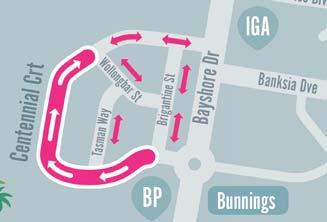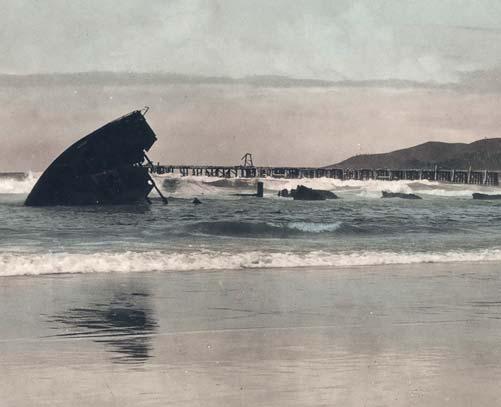
3 minute read
ago
Articles MAYDAY – MAYDAY – One hundred years ago
Byron Bay Historical Society
One hundred years ago this week, around noon on Saturday 14 May 1921, the 2,000 tonne steamship Wollongbar ran aground on Belongil beach.
The ship had been moored against the ‘old’ jetty and to a buoy in the sea. It was also anchored.
At about 11am gale-force, easterly winds and high seas pushed the ship away from the jetty and broke several of the mooring ropes. Before the remaining mooring ropes could be cast off , the anchor raised, and ‘full steam’ gained, the vessel had drift ed, struck bottom and began bumping along the seabed ‘broadside on’ closer and closer to the shore.
A desperate captain
Under full steam and with damaged propellers the desperate captain tried several times to turn the vessel toward the sea and sail to deeper water.
Each time the wind and waves prevailed, pushing the craft ever closer to the shore. Within half an hour the ten-year-old Wollongbar was hard aground on the beach with its stern facing the old jetty. Large waves rocked the vessel and scoured the seabed around it. Soon it had settled into the sand with huge waves crashing over the deck and superstructure.
Several members of the Byron Byron Bay Life Saving Club, as well as other locals, were immediately on the scene, and aft er many heroic attempts a line was linked from the shore to the boat.
No-one was seriously injured, and no-one was killed. Fortunately, none of the passengers due to depart the vessel to Sydney at 5pm that evening had boarded, otherwise the story may have had tragic outcomes. The next day being Sunday saw hundreds of spectators from Byron Bay and nearby towns visit the scene. The Wollongbar was fully loaded with more than 5,000 boxes of butter, 9,000 boxes of bananas and a large amount of bacon. Most of this cargo was retrieved and transported to shore using a flying fox rigged from the ship to dry land.
Several attempts were made to refloat the ship. All failed. The furniture and fittings were removed and sold or ‘acquired’ by locals. The number of chairs allegedly ‘recovered’ far exceeds the actual number of chairs on the ship at the time.
The wreck was sold to salvagers, who took all they could but abandoned the hull and boilers. The ship broke into pieces that are still partly visible at low tides and between waves in storms. It is now locally known as ‘The Wreck’ and has become a favourite surfing location. The outline of the hull is still clearly visible from the air.
Loss of a crucial link
The loss of the Wollongbar was also the loss of a crucial link for passengers and freight from Byron Bay and its hinterland to the outside world. In fact, so vital was this link that the owner of the Wollongbar, the North Coast Steamship Navigation Company, had an identical ship built. It was imaginatively named the Wollongbar II and made its maiden voyage to Byron Bay on 11 January 1923. A longer and safer ‘new’ jetty was completed in 1928. The Wollongbar became a huge tourist attraction in Byron Bay then it broke up and became The Wreck; a haven for sea life and divers. Photos courtesy of the Byron Bay Historical Society.
The Wollongbar II
The Wollongbar II, the twin of the Wollongbar, also met an unfortunate fate. Aft er loading a cargo of bacon and butter at Byron Bay, and a later departure for Sydney than planned on the evening of 28 April 1943, the Wollongbar II was torpedoed by Japanese submarine 1-180.
It was attacked and sank off Crescent Head, approximately 280 kilometres south of Byron Bay.
Two torpedos hit the ship in quick succession at 10.15am on 29 April 1943 breaking it in two. Both pieces sank within minutes giving those onboard little chance of escaping. Only five of the crew of 37 survived. Byron Bay captain
The captain and many others who died were from Byron Bay.
The delayed departure of the Wollongbar II from Byron Bay resulted from time it spent searching for survivors of the freighter Limerick which has sunk 32km off Cape Byron two days previously, aft er being fired on by the Japanese submarine 1-126 on 26 April.
Thirty-seven ships were attacked by enemy action along the eastern coast of Australia during WWII.
Byron Arts and Industry Estate





